Native to the eastern U.S., highbush (
Vaccinium corymbosum) and lowbush (
Vaccinium angustifolium) blueberries thrive in our acidic soils and plentiful rainfall, making them one of the easiest of edible plants to grow in home gardens.
Highbush blueberry is the taller shrub species, with large berries ranging in flavor from sweet to tart. Lowbush blueberries are the famous blueberries of northern New England, producing small but strongly flavored fruits that are a staple agricultural crop in Maine and were once an important food for native Americans.
By choosing varieties of blueberry that are suitable for your region’s climate and your own garden soil, you and the birds can enjoy their delectable berries for many decades to come.
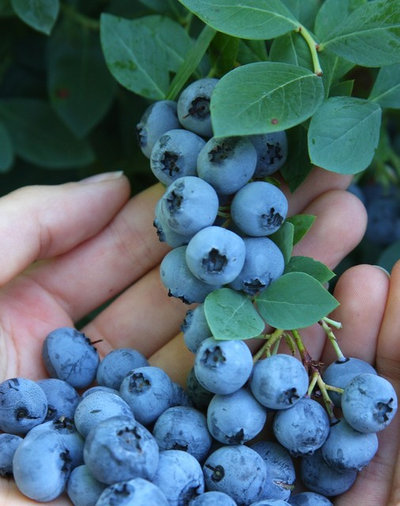
Monrovia
Botanical names:
Vaccinium corymbosum,
Vaccinium angustifoliumCommon names: Northern highbush blueberry and southern highbush blueberry, lowbush blueberry
Origin: Several varieties of highbush blueberry (
Vaccinium corymbosum) grow wild in wetlands and open fields along the East Coast west to the Great Lakes; northern highbush grows in the colder winters from Virginia north and southern highbush thrives in the heat and humidity of the south; lowbush blueberry (
V. angustifolium) has a wider range, native to the pine barrens and heathlands of the American east south to Florida and west to Texas
Where it will grow: Northern highbush: zones 4-7. Southern highbush: zones 7-10. Lowbush blueberry: zones 3-7.
Mature size: Highbush: 3 to 10 feet high, 3 to 10 feet wide; Lowbush: 8 to 24 inches high, 1 to 3 inches wide.
Benefits and tolerances: Antioxidant-rich blueberries are a valued native food for people and wildlife; established blueberry plants tolerate drought and salt spray; lowbush blueberry grows in dry, acidic, rocky or sandy soils with low fertility where many other plants won’t thrive
Seasonal interest: Small, white flowers in spring; blue and black berries in summer; flaming fall foliage — highbush blueberry foliage is burgundy red, lowbush is a fiery orange red
Soil requirements: Highbush blueberry grows in acidic, well-drained soil high in organic matter; lowbush blueberry grows in any well-drained acidic soil
Light requirements: Highbush blueberry needs full sun; lowbush blueberry grows in sun or shade but needs full sun for best flowering and fruit
Moisture requirements: Heavier for highbush blueberry; low for lowbush blueberry
When to plant: Plant containerized blueberries in early spring to allow fibrous root systems time to establish before winter; sow seeds in fall for spring germination (plants grown from seed will take 3 to 5 years to begin significant harvest)
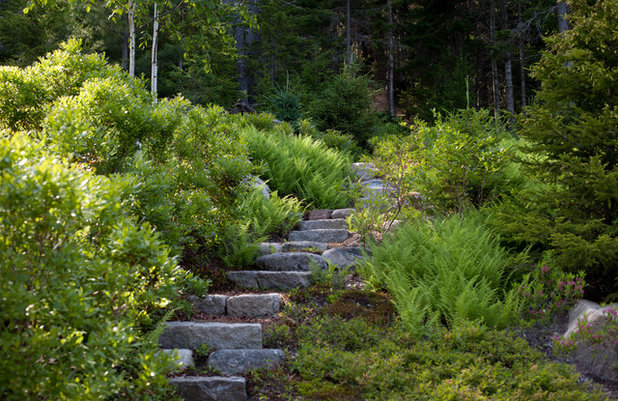
Matthew Cunningham Landscape Design LLC
Distinguishing traits. Highbush blueberry has a clumping habit, and mature shrubs develop a tight spreading crown. Lowbush blueberry forms colonies from spreading rhizomes. Both have semi-evergreen foliage in milder climates.
How to use it. Grow highbush blueberry in an open, sunny area where you can admire its fall foliage and the bird activity that it’s guaranteed to attract. Lowbush blueberry can be used for a spreading ground cover under pine trees or on a rocky slope, in a spot where it receives at least a half-day of sun.
Shown: A sloping garden path on Maine’s Mount Desert Island incorporates highbush blueberry (on left) and lowbush blueberry (on right), along with ferns and other woodland natives.
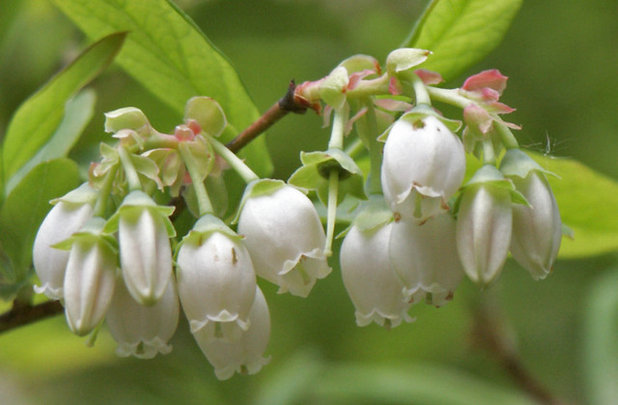
Ellen Sousa/Turkey Hill Brook Farm
Wildlife value. The abundant small white flowers are an important spring nectar source for native bees, such as bumble bees and mining bees, and fruits are a favorite of birds and mammals.
Vaccinium foliage is an important food plant for a wide variety of rare and common butterfly and moth caterpillars.
Bumble bees are especially important to blueberry pollination — by buzzing their flight muscles inside blueberry flowers, they shake pollen loose onto their furry bodies that they carry to other flowers, significantly improving cross-pollination and fruit set. Support those bumble bees the rest of the blooming season by growing lots of other flowering nectar plants in your garden to provide them with nectar through summer and into fall.
Because birds love blueberries as much as we do, you may need to net your plants when berries start to form to keep the birds from stripping them all before they ripen.
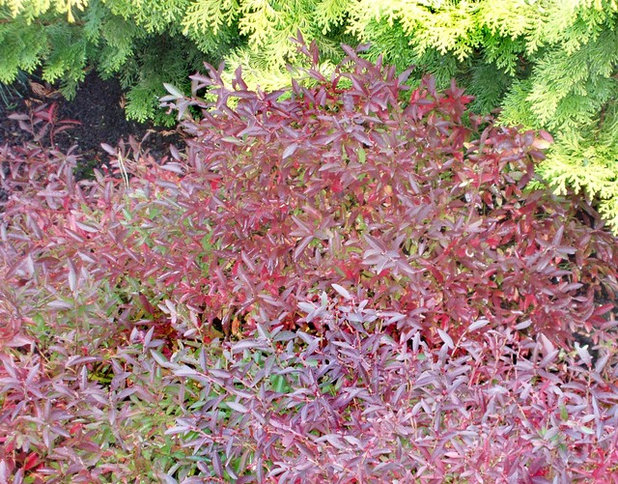
Monrovia
Planting notes. Plant highbush blueberries 5 feet apart in holes twice as large as the roots, and incorporate plenty of organic matter such as leaf mold, leaf compost, rotted sawdust or fine bark mulch into the planting hole.
Space lowbush blueberries a few feet apart, giving them room to spread naturally. Mulch around plants well with a 3-inch layer of leaf mold, pine needles or wood chips to protect shallow roots from winter heave and improve moisture retention. Keep your blueberries well-weeded to reduce competition for moisture in the root zone.
Although blueberries can self-pollinate, planting several different cultivars from the same species for cross-pollination results in larger fruits and yields. Be sure to choose varieties with overlapping bloom times — plant labels should state whether a cultivar is early-, mid- or late-blooming.
Blueberries can also be grown in containers, but choose a large container (at least 18 inches) and use a bark or woodchip-based potting mix specially made for acid-loving plants such as rhododendrons and azaleas. Apply a thick mulch around the plant, keep well-watered, especially in the spring and summer, and fertilize container plants in early spring with an organic fertilizer formulated for acid-loving plants. Good nurseries should carry these products.
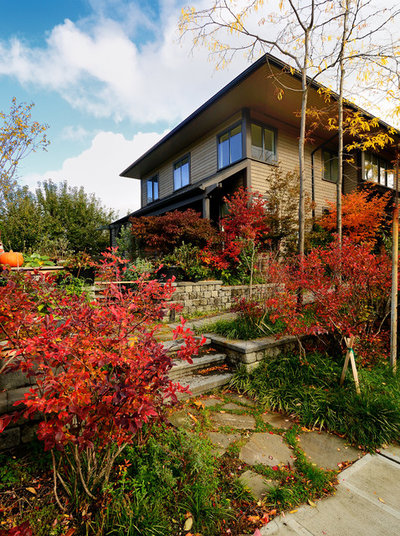
Studio Ectypos
Propagating blueberries. Take highbush cuttings from soft new suckering shoots in early summer, treat with rooting hormone, plant in a light seedling mix and keep moist. Divide lowbush blueberry before growth begins in spring by cutting off 3- to 8-inch shoots with attached rhizome, replanting and mulching well.
Growing from seed. Pick ripe berries and remove the pulp with its seeds. Smear pulp onto some paper and allow to dry for a few days. Extract and separate the tiny brown seeds from the pulp. Rub off any remaining attached skin and sow seeds immediately outdoors in a container (or a well-protected area in the ground) and keep area moist through the fall. Seeds should germinate by the following spring and can be container-grown for a few years to develop or planted directly in the ground and mulched well. Prune off flower buds in the first few years to encourage strong root growth.
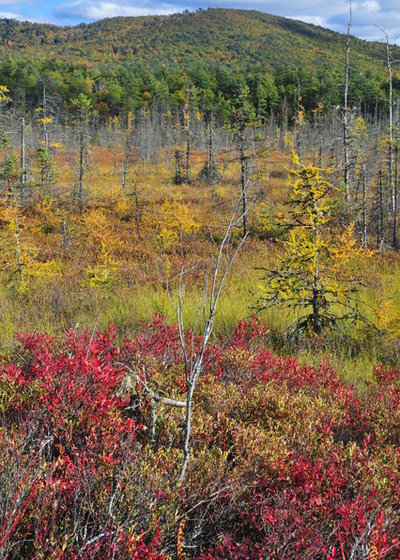 Pruning
Pruning. If you’re growing highbush blueberries to harvest, begin a pruning regime after fruits form in the third year after planting. Remove the oldest, darkest stems to open up the center of the plant to sunlight. Lowbush blueberry can be pruned to the ground every few years to improve yields. For a more natural form, do not prune and allow plants to take on their wild craggy form.
Shown: The iconic red splash of blueberry foliage in a bog in New Hampshire’s Lakes Region.
More guides to growing summer edibles





